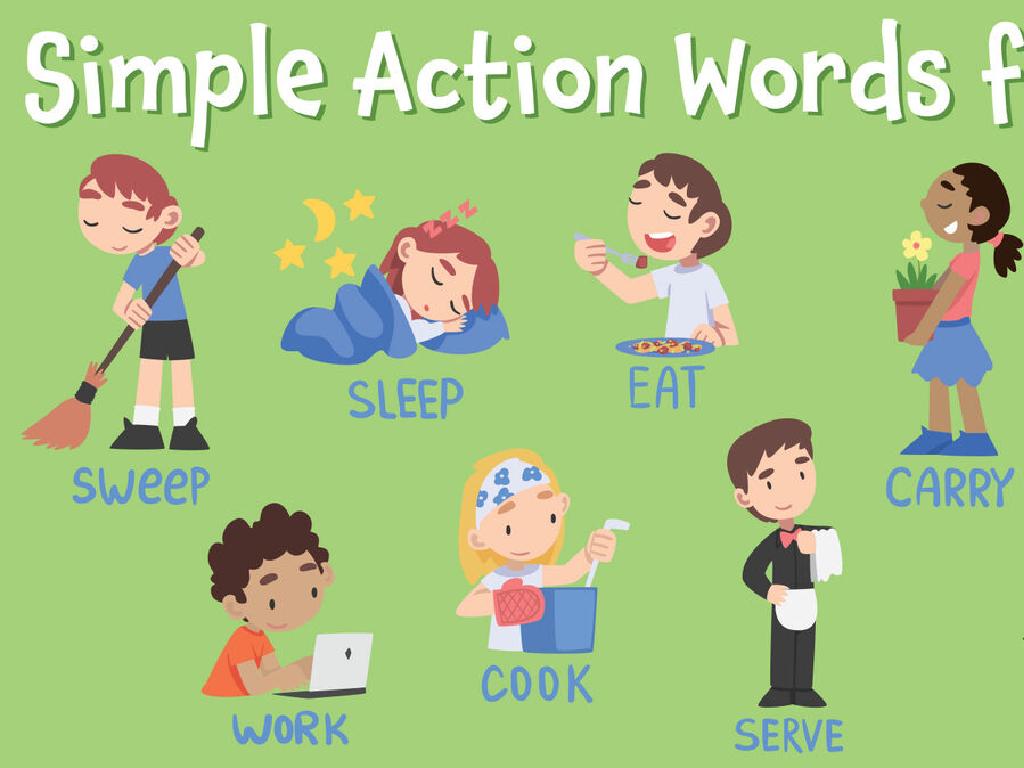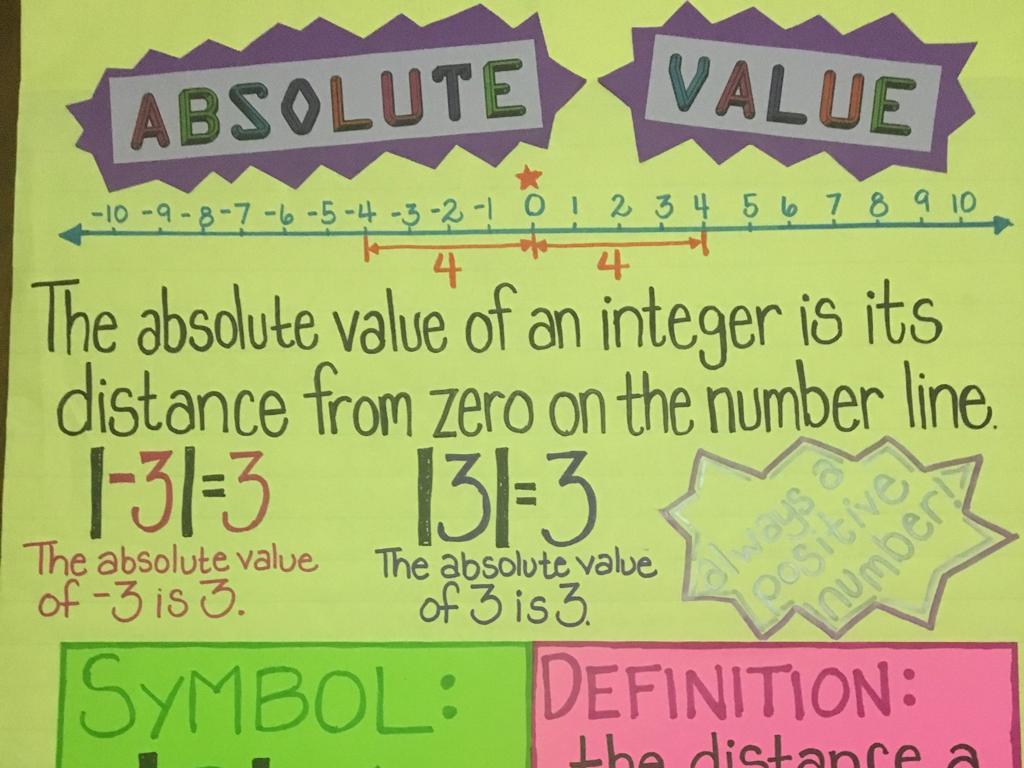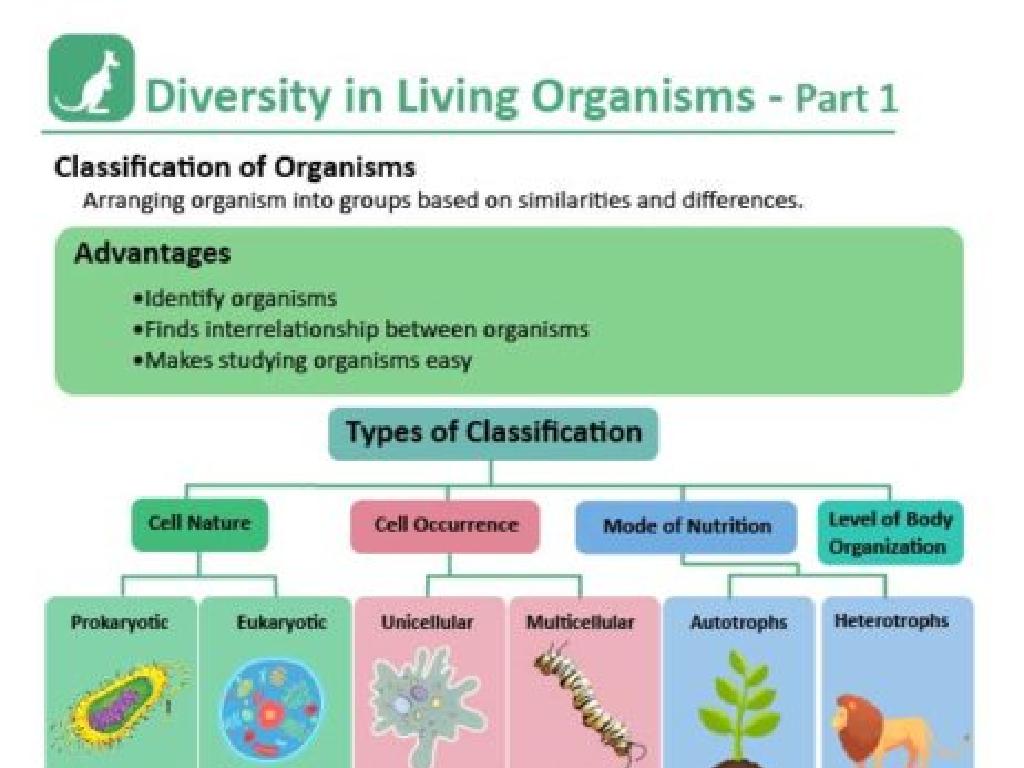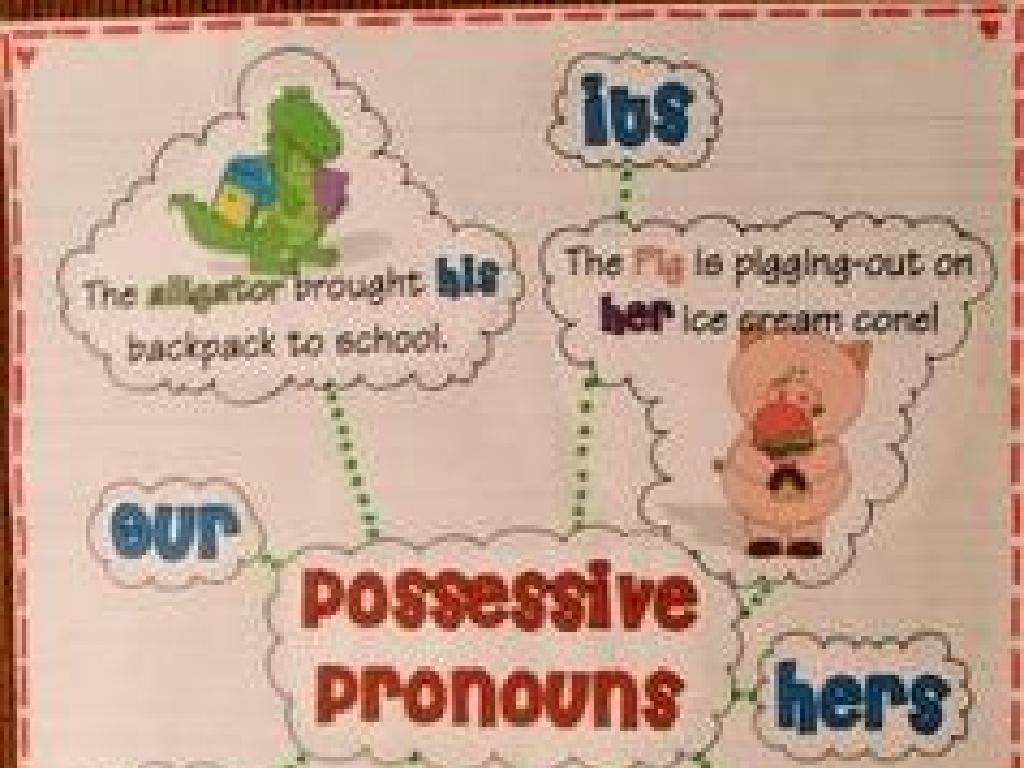Form And Use The Regular Past Tense
Subject: Language arts
Grade: Third grade
Topic: Verb Tense
Please LOG IN to download the presentation. Access is available to registered users only.
View More Content
Exploring Past Tense Verbs
– Understanding verb tenses
– Verb tenses tell us when an action happens
– Defining a verb
– A verb is an action word like ‘run’, ‘talk’, ‘eat’
– Learning about past tense
– Past tense verbs tell about actions that have already happened
– Regular past tense formation
– Add ‘ed’ to most verbs to show past action, like ‘walk’ becomes ‘walked’
|
This slide introduces the concept of verb tenses, focusing on the past tense for regular verbs. Begin by explaining that verb tenses indicate the timing of an action. Clarify what a verb is with familiar examples. Emphasize that past tense verbs are used to describe actions that were completed in the past. Teach the rule for converting most regular verbs into the past tense by adding ‘ed’ at the end. Provide examples and encourage students to think of verbs they use daily and how they would change them into the past tense. This will set the foundation for more complex verb tense lessons.
Understanding Past Tense
– Past tense describes past actions
– Tells us what happened before now
– It’s used for completed activities
– Like yesterday’s fun at the park
– Examples: ‘walked’, ‘talked’, ‘played’
– ‘I walked to school’, ‘We talked at lunch’
– Regular verbs end in ‘ed’
– ‘Jump’ becomes ‘jumped’, ‘paint’ becomes ‘painted’
|
This slide introduces the concept of the past tense, which is a fundamental part of English grammar. It’s important for students to understand that past tense verbs are used to describe actions that have already happened. Regular past tense verbs typically end with ‘ed’. Provide clear examples like ‘walked’, ‘talked’, and ‘played’ to illustrate regular past tense formation. Encourage students to think of actions they did yesterday or earlier in the day and to practice turning present tense verbs into past tense by adding ‘ed’. This will help them grasp the concept of regular past tense verbs.
Regular Past Tense Verbs
– Forming the past tense
– Add ‘-ed’ to most verbs
– When we talk about things that happened before now, we use the past tense.
– Example: ‘walk’ to ‘walked’
– ‘I walk to school every day’ changes to ‘Yesterday, I walked to school.’
– Example: ‘jump’ to ‘jumped’
– ‘She jumps rope during recess’ changes to ‘She jumped rope yesterday.’
|
This slide introduces the concept of regular past tense verbs to third-grade students. Emphasize that to talk about something that happened in the past, we often add ‘-ed’ to the end of the verb. Use familiar and easy verbs like ‘walk’ and ‘jump’ as examples. Explain that this rule applies to most verbs in the English language. Encourage students to think of verbs they use daily and practice converting them to the past tense. Provide additional examples and ask students to come up with sentences using both the present and past tense forms of the verbs for practice.
Past Tense Spelling Rules
– Add ‘d’ to verbs ending in ‘e’
– For ‘love’, drop the ‘e’ and add ‘d’ to make ‘loved’
– Change ‘y’ to ‘i’, then add ‘ed’
– For ‘cry’, replace ‘y’ with ‘i’ and add ‘ed’ for ‘cried’
– Double consonant and add ‘ed’
– For ‘stop’, double the ‘p’ and add ‘ed’ to get ‘stopped’
|
This slide introduces students to the spelling rules for forming the past tense of regular verbs. It’s crucial to explain that these rules help us write verbs correctly in the past tense. Start with verbs ending in ‘e’, where students only need to add ‘d’. Then, discuss verbs ending in ‘y’ preceded by a consonant, which require changing ‘y’ to ‘i’ before adding ‘ed’. Lastly, teach the rule for verbs ending with a single vowel followed by a consonant, where the consonant should be doubled before adding ‘ed’. Provide additional examples for each rule and encourage students to come up with their own examples. Practice these rules through written exercises and interactive activities.
Pronunciation of ‘-ed’ in Past Tense
– ‘-ed’ sounds like ‘t’, ‘d’, or ‘id’
– ‘t’ sound after unvoiced sounds
– For example, ‘kiss’ becomes ‘kissed’
– ‘d’ sound after voiced sounds
– For example, ‘play’ becomes ‘played’
– ‘id’ sound after ‘t’ or ‘d’
– For example, ‘want’ becomes ‘wanted’
|
When teaching the pronunciation of the ‘-ed’ ending in regular past tense verbs, it’s crucial to help students recognize the different sounds ‘-ed’ can make, which are ‘t’, ‘d’, and ‘id’. The ‘t’ sound occurs after unvoiced sounds, like in ‘kissed’, where the base verb ends in a soft sound. The ‘d’ sound follows voiced sounds, such as in ‘played’, where the base verb ends in a more resonant sound. Lastly, the ‘id’ sound is used when the base verb ends in a ‘t’ or ‘d’, like in ‘wanted’. Encourage students to practice by providing a list of regular verbs and asking them to form the past tense and pronounce them correctly. This will help them understand and remember the rules for past tense pronunciation.
Let’s Practice: Regular Past Tense
– Change verbs to past tense
– ‘ask’ becomes ‘asked’
– Just add ‘ed’ to the end of ‘ask’
– ‘clean’ becomes ‘cleaned’
– Add ‘ed’ to ‘clean’ for past tense
– ‘dance’ becomes ‘danced’
– ‘dance’ gets an ‘ed’ too!
– ‘enjoy’ becomes ‘enjoyed’
– For ‘enjoy’, we add ‘ed’ after dropping the ‘y’
|
This slide is an activity for students to practice converting present tense verbs to their regular past tense forms. Remind students of the spelling rules: for most verbs, simply add ‘ed’ to the end. If the verb ends in ‘y’, replace ‘y’ with ‘ied’. Encourage students to say the verbs out loud in their past tense forms to reinforce the lesson. Prepare to correct common mistakes, such as forgetting to drop the ‘y’ before adding ‘ed’. Have additional verbs ready for students who finish early, and consider pairing students to practice together.
Irregular Past Tense Verbs
– Some verbs break the rules
– ‘Go’ changes to ‘went’
– Unlike ‘walked’, ‘go’ doesn’t add -ed
– ‘Have’ turns into ‘had’
– Just like ‘go’, ‘have’ changes form
– Memorization is key
– Practice makes perfect for these verbs
|
This slide introduces irregular past tense verbs to third-grade students, emphasizing that not all verbs follow the regular pattern of adding -ed to form the past tense. Provide examples of common irregular verbs and highlight the changes they undergo when used in the past tense. It’s important to let students know that these verbs need to be memorized because they don’t follow the regular rules. Encourage students to practice these irregular forms through reading and writing exercises, and consider creating flashcards or engaging activities to aid memorization. Remind them that with practice, they will become more familiar with these exceptions to the rules.
Story Time: Spot the Past Tense Verbs
– Listen to a past-tense story
– Find regular past tense verbs
– Verbs that ended with ‘ed’ like ‘walked’, ‘jumped’
– Understand how they are used
– See how these verbs tell us about actions that are finished
– Get ready to share your finds
|
This slide is for an interactive story-listening activity where students will practice identifying regular past tense verbs. Play a short story or read aloud to the class, ensuring the story contains a good number of regular past tense verbs. Encourage students to listen carefully and spot verbs that are in the past tense, particularly those that end in ‘ed’. After the story, discuss how these verbs are used to describe actions that have already happened. Ask students to share the past tense verbs they found and use them in their own sentences. This will help reinforce their understanding of verb tenses and how they are used in storytelling and everyday communication.
Class Activity: Time Travelers
– Imagine time traveling back
– Write 3 past tense sentences
– Use verbs ending in ‘ed’ like ‘jumped’, ‘played’, ‘asked’
– Share your time travel story
– Reflect on using past tense verbs
– Think about how the verbs show actions that are finished
|
This activity is designed to help students practice using the regular past tense in a fun and imaginative way. Encourage them to think creatively about where they would go if they could travel back in time. Guide them to write three sentences describing their actions using regular past tense verbs, typically ending in ‘ed’. For example, ‘I visited the dinosaurs’, ‘I talked to a pharaoh’, or ‘I watched the first airplane fly’. After writing, students will share their adventures with the class, which will help them practice speaking in the past tense and also allow them to listen to how their classmates use the past tense. This will reinforce their understanding of verb conjugation in a narrative context. Provide feedback and correct as necessary to ensure proper usage of the past tense.






